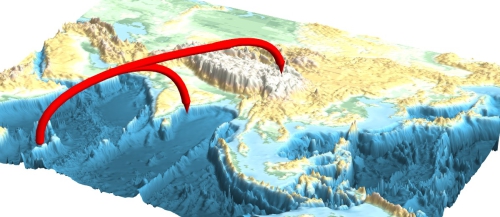Previous studies have indicated that, as a capacitor of ENSO (El Nino–Southern Oscillation) signals, the IOBM (Indian Ocean Basin Mode) can maintain such signals in boreal winter until spring and summer of the following year, and further modulate the Asian summer monsoon. Meanwhile, the so-called ‘sensible-heat pump’ over the Tibetan Plateau (TP) is also considered to be a key factor in the nature of the Asian summer monsoon (ASM). Combining these two aspects, a clearer understanding of the Asian monsoon requires us to investigate the relationship between the adjacent plateau heat source and the remote large-scale SST forcing in the Indian Ocean.
Considering the very different background circulation in different stages of ASM onset, the traditional seasonal-mean viewpoint on this topic may obscure some important information. Choosing instead to study the issue on a month by month basis, Prof. DUAN Anmin and his PhD Student, ZHAO Yu, from the Institute of Atmospheric Physics, Chinese Academy of Sciences, found that, with the seasonal evolution from winter to summer and the northward movement of the westerly jet, the surface wind changes its direction after the onset of the summer monsoon over the Bay of Bengal, and the surface sensible heating of the TP is closely related to the IOBM signal in May, which is totally different from the case in February–April.

IOBM-induced circulation behaves like a reinforced local Hadley circulation arising from the southwestern tropical Indian Ocean and descending in the Bay of Bengal and the southeastern Tibetan Plateau (red vector). (Image by IAP)
Results from both data diagnosis and numerical simulation suggest that, due to the intensified local Hadley cell during IOBM warm-phase years, the cloud amount, radiation flux and precipitation over the plateau carry significant influence, inducing the significantly intensified in-situ surface heat source. This work provides further insight into the intrinsic connection between remote oceanic forcing and the TP heat source, with emphasis on the land–air–sea interaction in the nature of monsoon and Earth’s climate system.
Reference
Zhao, Y., A. M. Duan, and G. X. Wu, 2018: Interannual variability of late-spring circulation and diabatic heating over the Tibetan Plateau associated with Indian Ocean forcing. Adv. Atmos. Sci., 35(8), doi: 10.1007/s00376-018-7217-4. https://link.springer.com/article/10.1007/s00376-018-7217-4
Media Contact: LIN Zheng, jennylin@mail.iap.ac.cn
